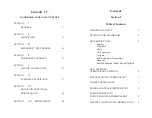
737 MAX Flight Crew Operations Manual
Air Systems -
Air Conditioning System
Description
2.30.2
MN-FLT-OH-201
When the aircraft is on the ground or the flaps are down, and both air conditioning
pack switches are set to AUTO, and engine bleed switches are both set to ON, if
one pack fails or one engine fails or a pack switch is selected to OFF, the
remaining pack will not automatically transfer to high air flow. Automatic
transferring to high air flow is inhibited in this situation to ensure adequate engine
power is available for single engine operations. However, when the APU is
operating and the APU bleed switch is set to ON, both engine bleed switches are
set to OFF and both pack switches are set to AUTO, automatic transferring to high
air flow occurs with a single pack failure, regardless of flap position or air/ground
status. Also, in this configuration, the flight crew can force an "APU high flow"
rate when either or both pack switches are positioned to HIGH, providing
maximum airflow for ventilation when the APU is the only source of ventilation.
Ram Air System
The ram air system provides cooling air for the heat exchangers. Operation of the
system is automatically controlled by the packs through operation of ram air inlet
doors.
On the ground, or during slow flight with the flaps not fully retracted, the ram air
inlet doors move to the full open position for maximum cooling. In normal cruise,
the doors modulate between open and closed.
Deflector doors are installed forward of the ram air inlet doors to prevent slush
ingestion prior to liftoff and after touchdown. Deflector doors extend when
activated electrically by the air–ground safety sensor.
Cooling Cycle
Flow through the cooling cycle starts with bleed air passing through a heat
exchanger for cooling. The air then flows to an air cycle machine for refrigeration.
The processed cold air is then combined with hot air which has bypassed the air
cycle machine, then through a high pressure water separator which removes
moisture. This conditioned air then flows into the mix manifold and distribution
system.
Overheat protection is provided by temperature sensors located in the cooling
cycle. An overheat condition causes the pack valve to close and the PACK light to
illuminate.
Pack Temperature Control
The IASCs command the pack temperature control valve open or closed to satisfy
pack discharge requirements.
March 1, 2021













































